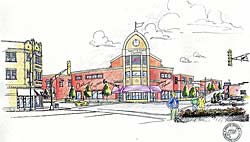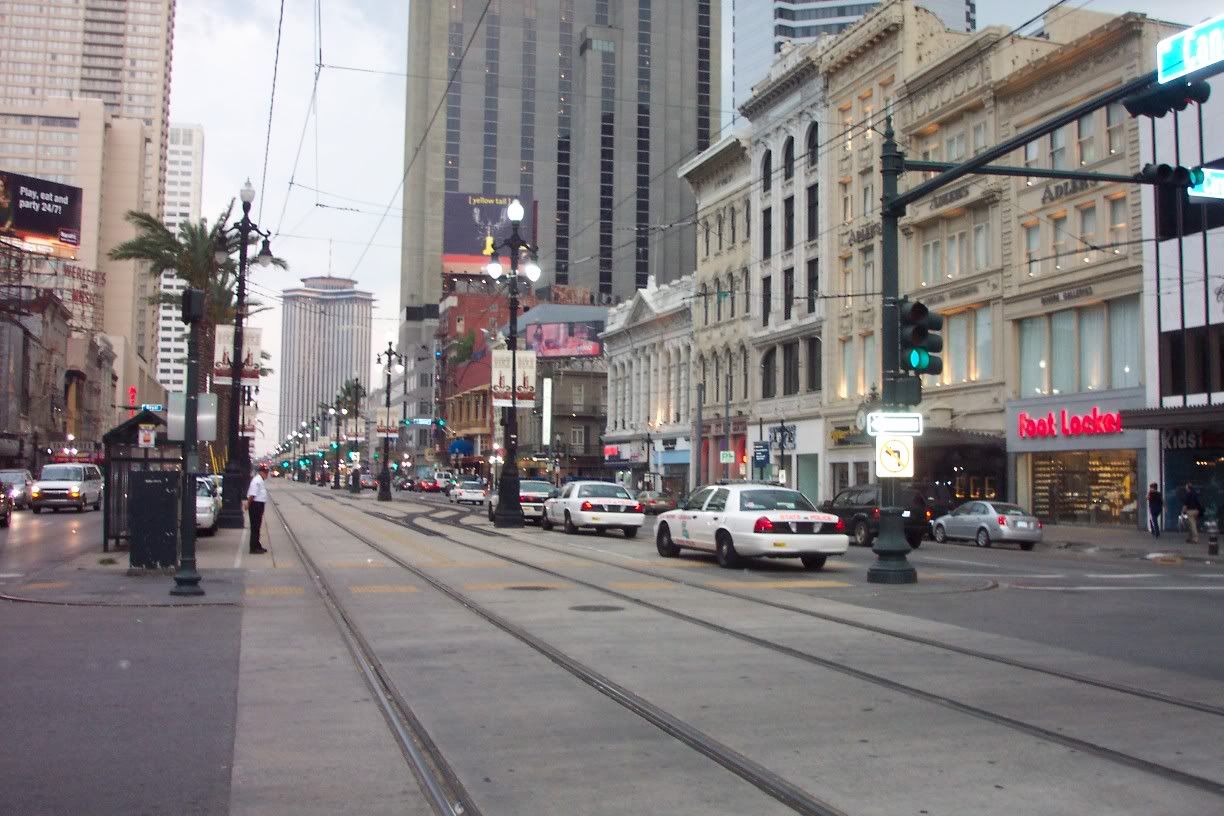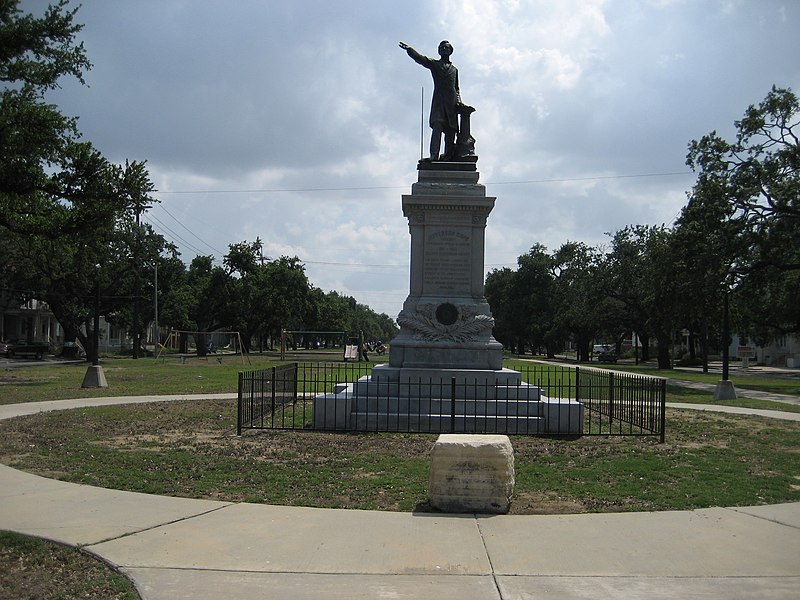As demolition of the Doctor's Building is complete, and the threat of the San Luis Apartments demolition grows more tangible, I just have to ask one question regarding the targeting of mid-century architecture and what ultimately replaces it: why?
In the case of the Doctor's Building, the new denizen of the site will at least be urban in form and keep a mixed-use presence on the site, even filling in the land on which the parking lot that the Doctor's Building originally claimed for its own construction rests. But concerns over why the building had to be demolished at all remain, as well as doubts about the quality of the design of the new project. Michael Allen wrote
a beautiful essay on the Doctor's Building and another
on his qualms about the proposed development over at Ecology of Absence.
In the case of the San Luis Apartments, (or crazy, funky mod building with three compound fractures, if you will) the St. Louis Archdiocese intends to turn the site into a surface parking lot. Vanishing STL has more on their plans to establish a "campus" where now only a "hodgepodge that happened over time" exists with regards to buildings. Those are the words of our spiritual leaders, folks.
Check the full story out here.
I might add, on a bit of a tangent, that this "campus" mentality is what fuels St. Louis University to rid of its own troublesome "hodgepodge" and seek a unified, faux-Gothic appearance punctuated by green space. It's as if the city and its neighborhoods are once again canvasses from a time of urban renewal, where blocks can be closed, buildings torn down, people uprooted, churches and institutions drained of their members, and once active urban spaces with the potential to be such again reduced to parking lots and garages--all in the name of creating a logical "campus". It's a mortifying confirmation of SLU's and the Archdiocese's view of the city and their respective roles within it--that the city's complexities, those that render it interesting and unpredictable and urban, can be done away with in order to produce a sterilized, definable, controllable, and marketable "place."
Any Mid-Century Modern proponent should look further back to what is St. Louis's perhaps most egregious abuse of land in a direct violation of what neighborhood residents originally demanded. Look no further than the northeast corner of the intersection of Chippewa and Kingshighway, where four neighborhoods and a whole lot of pedestrian and automobile traffic converge.

This was what the corner used to convey when the old Famous-Barr Southtown store was constructed in 1951. Though its massive scale and caustic materials may have hurt its chances at recognition as "historic" in the 21st century, there is a lot to commend about this structure, demolished in 1995. In typical streamlined modern fashion, the building adhered to a classical form while showing it up on the massing and using bolder materials. That is, this building has great respect for this large and heavily trafficked corner with its dramatic curvaceousness. It commandeered this intersection with its very presence, so much so that one barely notices the gas station in the foreground. Combined with the northwestern block of buildings of this intersection, this is unmistakably an urban neighborhood.
Fast forward to 2005, and construction has been completed on a new commercial strip center over the site of the old Famous. The result is a dreary and awkward design that can't even compete with the suburban counterparts it has attempted to emulate. One of the outbuildings abuts Chippewa, albeit about eight feet above it, and shows its backside, literally and figuratively, to the passers-by below. A Walgreens store occupies the parcel closest to the corner, but with a spacious row of parking and a non-sensical triumphal arch/bus shelter(?) that urges the otherwise overlooked pedestrian to jog across a parking lot to purchase wares that can be found in an identical store in Des Peres or dozens of other St. Louis suburbs.



The neighborhood fought a K-Mart store that was interested in the 11 acre lot in the late 1990s and early 2000s. The "Southside Coalition" headed by John Klevorn pressed for an urban, mixed-use replacement to the felled Famous. Per an April 5, 2000 Riverfront Times article:
[14th Ward Alderman Stephen] Gregali, Klevorn and the Southside Coalition have a different plan for the long-empty corner, and Kmart is not a part of it. Instead of one "big-box" development, they envision two or three smaller stores, something along the lines of an Old Navy, Circuit City or T.J. Maxx, connected by smaller storefronts featuring the likes of a St. Louis Bread Co. or other small stores and restaurants. In their plan, the stores would be close to the street and the parking would be behind the stores -- still free, just not as visible from the street. The bricks and architecture would be more suited to the surrounding apartments and businesses, similar to the strip on South Grand Boulevard at Arsenal Street.
The coalition produced a rendering depicting what they would like on the site. Contrast it to the photos above.

Interestingly, this drama unfolded the year that Mayor Francis Slay, then President of the Board of Aldermen, began his first campaign against incumbent Clarence Harmon. Slay said of the Southtown site, "This issue is too important to sit idly by and watch from the sidelines."
This quote makes the result of the K-Mart protest all the more surprising. The announcement of a first ever urban PetSmart drew excitement, and the redundancy of an Office Max addition to the neighborhood (with the Office Depot store in the old Venture strip center further south on Kingshighway) was forgiven. And Walgreens did in fact move from a declining strip center across Chippewa to a new building on the site, as rumored. Failing to see the follies of shifting commercial boxes around doomed strip centers, the leadership suddenly dropped the activist role and began to back the development on the site as we now know it.
The recent exchange between Steve Patterson and still-Alderman Stephen Gregali is
classic and must be read to be believed. The Southtown reference is toward the end. At least Gregali spoke on the issue when prodded; in great irony, Mayor Slay has "sat idly by" and has remained mum.
Despite a new tenant (the Army Corps of Engineers) and a proposed pizza joint, the center has been a remarkable failure, with most of the storefronts on the northern building never even leased. An urban clothing store and a Verizon Wireless store have already faltered, and the Cold Stone Creamery had, at least at one point, switched to "seasonal" hours.
Okay. So what is my point? Go back to the beginning of this post and look at the old Famous building. Look at what replaced it. Do St. Louis and its leaders and residents not have the power or the will to demand better? In Southtown's case, all seemed aligned to ensure that the loss of this urban building would not be for naught; that the vacant lot would be filled with a worthy successor that would live to see not just its 50th, but perhaps its 100th anniversary. What happened? This case shows the vigilance and dedication it takes to be a proper steward to St. Louis's built environment. Vocal protest of a big box may not be enough; it may require vocal advocacy for what would be better than the box.
In retrospect, or at least in comparison to what's there today, the mid-century Southtown Famous Barr should have remained; its presence was stunning and bold and, yes, even urban. Mixed-use redevelopment of the building seemed entirely possible with a creative mind and equally creating financing. Instead we have lost not just a magnificent urban department store, we have lost that very corner itself.
Who knows how long it will be until this site is rebuilt again. Will we, at that point, demand something lasting, something beautiful, something truly fitting for St. Louis? Or will we play strip center shuffle yet again?
Let this stand as a warning for West Pine and Euclid, and for Taylor and Lindell. That mid-century building you think is ugly and outmoded--wait until you see what
this century produces.
[Photographs of Southtown Centre courtesy of
Urban Review St. Louis.]













